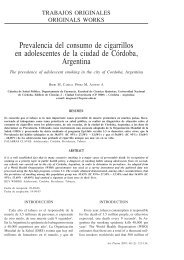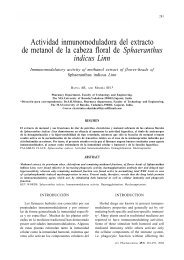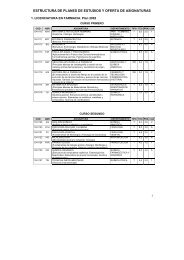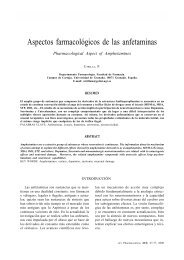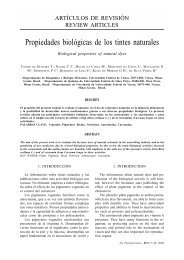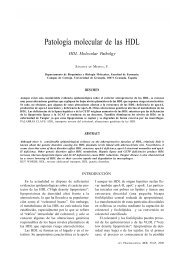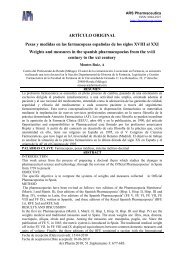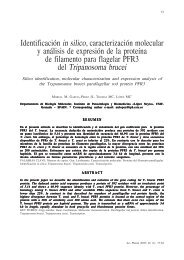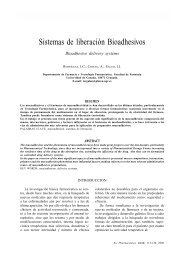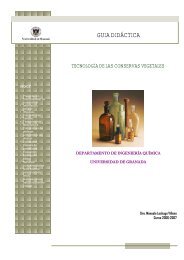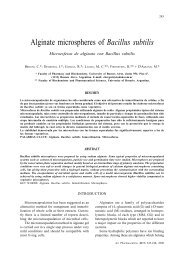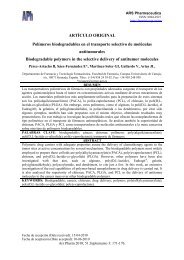Péptidos y proteínas de la leche con propiedades funcionales
Péptidos y proteínas de la leche con propiedades funcionales
Péptidos y proteínas de la leche con propiedades funcionales
You also want an ePaper? Increase the reach of your titles
YUMPU automatically turns print PDFs into web optimized ePapers that Google loves.
PÉPTIDOS Y PROTEÍNAS DE LA LECHE CON PROPIEDADES FUNCIONALES<br />
<strong>Péptidos</strong> y <strong>proteínas</strong> <strong>de</strong> <strong>la</strong> <strong>leche</strong><br />
<strong>con</strong> propieda<strong>de</strong>s <strong>funcionales</strong><br />
Bioactive milk peptidos and proteins<br />
BARÓ L 1 , JIMÉNEZ J 1 , MARTÍNEZ-FÉREZ A 2 Y BOUZA JJ 1 .<br />
1 Puleva Biotech S.A. Camino <strong>de</strong> Purchil 66, 18004 Granada (España)<br />
2 Dpto. Ingeniería Química, Universidad <strong>de</strong> Granada<br />
E-mail: Ibaro@puleva.es<br />
RESUMEN<br />
La fracción proteica <strong>de</strong> <strong>la</strong> <strong>leche</strong> <strong>con</strong>tiene un gran número <strong>de</strong> compuestos biológicamente activos. A<strong>de</strong>más <strong>de</strong> <strong>la</strong>s<br />
<strong>proteínas</strong> <strong>de</strong> <strong>la</strong> <strong>leche</strong>, caseínas y <strong>proteínas</strong> <strong>de</strong>l suero lácteo, existen también pequeñas cantida<strong>de</strong>s <strong>de</strong> otras <strong>proteínas</strong><br />
y péptidos. Estos péptidos, que son inactivos <strong>de</strong>ntro <strong>de</strong> <strong>la</strong> secuencia <strong>de</strong> <strong>la</strong> proteína nativa, pue<strong>de</strong>n ser liberados por<br />
hidrólisis enzimática, por ejemplo, durante <strong>la</strong> digestión gastrointestinal o durante el procesado <strong>de</strong>l alimento. Estos<br />
péptidos bioactivos proce<strong>de</strong>ntes <strong>de</strong> <strong>proteínas</strong> lácteas presentan una actividad modu<strong>la</strong>dora <strong>de</strong> numerosos procesos<br />
metabólicos <strong>de</strong>l organismo. Asimismo, <strong>la</strong>s <strong>proteínas</strong> <strong>de</strong>l suero lácteo representan una mezc<strong>la</strong> variada <strong>de</strong> <strong>proteínas</strong><br />
secretadas, tales como á-<strong>la</strong>ctoalbúmina, â-<strong>la</strong>ctoglobulina, <strong>la</strong>ctoferrina, <strong>la</strong>ctoperoxidasa, inmunoglobulinas,<br />
glicomacropéptido y una gran cantidad <strong>de</strong> factores <strong>de</strong> crecimiento. Estas <strong>proteínas</strong> tienen una serie <strong>de</strong> efectos<br />
biológicos, que van <strong>de</strong>s<strong>de</strong> un efecto anticancerígenos hasta efectos en <strong>la</strong> función digestiva.<br />
PALABRAS CLAVE: Leche. Proteinas. <strong>Péptidos</strong><br />
ABSTRACT<br />
Milk protein fraction <strong>con</strong>tains many biologically active compounds. Besi<strong>de</strong>s milk proteins, caseins, and milk whey<br />
proteins, it also <strong>con</strong>tains low amounts of other proteins and pepti<strong>de</strong>s. These pepti<strong>de</strong>s, which are inactive within the<br />
sequence of the native protein, can be released by enzymatic hydrolysis, for example during gastrointestinal digestion,<br />
or during food processing. These bioactive pepti<strong>de</strong>s from milk proteins are potential modu<strong>la</strong>tors of several metabolic<br />
processes in the body. Moreover, milk whey proteins are a varied mixture of secreted proteins, such as ?-<strong>la</strong>ctalbumin,<br />
?-<strong>la</strong>ctoglubulin, <strong>la</strong>ctoferrin, <strong>la</strong>ctoperoxidase, immunoglobulins, glycomacropepti<strong>de</strong>s and a <strong>la</strong>rge amount of growth factors.<br />
These proteins have some biological effects, ranging from an anticarcinogenic effect to effects on the digestive function.<br />
KEY WORDS: Milk. Proteins. Pepti<strong>de</strong>s<br />
PÉPTIDOS BIOACTIVOS<br />
Las <strong>proteínas</strong> <strong>de</strong> <strong>la</strong> dieta aportan los aminoácidos<br />
necesarios para el <strong>de</strong>sarrollo y mantenimiento<br />
<strong>de</strong> célu<strong>la</strong>s y tejidos <strong>de</strong> nuestro organismo.<br />
Como <strong>con</strong>secuencia <strong>de</strong> <strong>la</strong> digestión <strong>de</strong> <strong>la</strong>s<br />
<strong>proteínas</strong>, a<strong>de</strong>más <strong>de</strong> aminoácidos libres, se liberan<br />
péptidos, que son ca<strong>de</strong>nas <strong>con</strong> distintos<br />
números <strong>de</strong> aminoácidos. En los últimos años<br />
existe un creciente interés por <strong>de</strong>terminados fragmentos<br />
específicos <strong>de</strong> <strong>la</strong>s <strong>proteínas</strong> <strong>de</strong> <strong>la</strong> dieta<br />
ARTÍCULOS DE REVISIÓN<br />
REVIEW ARTICLES<br />
BIOACTIVE PEPTIDES<br />
135<br />
Diet proteins supply the required aminoacids<br />
for the <strong>de</strong>velopment and maintenance of the cells<br />
and tissues of the organism. As a result of protein<br />
digestion, besi<strong>de</strong>s free aminoacids, pepti<strong>de</strong>s,<br />
that is, chains of different numbers of aminoacids,<br />
are also released. Lately there has been<br />
an increasing interest in some specific proteic<br />
fragments present in the diet that, besi<strong>de</strong>s their<br />
nutritional value, have a biological effect, as<br />
Ars Pharmaceutica, 42:3-4; 135-145, 2001
136<br />
que tienen una actividad biológica, regu<strong>la</strong>ndo<br />
procesos fisiológicos, a<strong>de</strong>más <strong>de</strong> su valor nutricional.<br />
La literatura científica evi<strong>de</strong>ncia que estos<br />
péptidos bioactivos pue<strong>de</strong>n atravesar el epitelio<br />
intestinal y llegar a tejidos periféricos vía<br />
circu<strong>la</strong>ción sistémica, pudiendo ejercer funciones<br />
específicas a nivel local, tracto gastrointestinal,<br />
y a nivel sistémico. Dentro <strong>de</strong> estas activida<strong>de</strong>s,<br />
los péptidos biactivos podrían alterar el<br />
metabolismo celu<strong>la</strong>r y actuar como vasoregu<strong>la</strong>dores,<br />
factores <strong>de</strong> crecimiento, inductores hormonales<br />
y neurotransmisores¹<br />
Origen <strong>de</strong> <strong>la</strong>s péptidos bioactivos<br />
Toda fuente <strong>de</strong> proteína alimentaria es susceptible<br />
<strong>de</strong> aportar péptidos <strong>funcionales</strong>, <strong>de</strong> forma<br />
que aparte <strong>de</strong> <strong>la</strong> <strong>leche</strong> humana y <strong>de</strong> vaca, que<br />
son los más estudiados, se han ais<strong>la</strong>do péptidos<br />
a partir <strong>de</strong> hidrolizados enzimáticos <strong>de</strong> <strong>proteínas</strong><br />
muy diversas: sardina, maíz, soja, ge<strong>la</strong>tina...². En<br />
<strong>la</strong> bibliografía po<strong>de</strong>mos en<strong>con</strong>trar un gran número<br />
<strong>de</strong> artículos re<strong>la</strong>cionados <strong>con</strong> los aspectos<br />
estructurales, fisiológicos y analíticos <strong>de</strong> los<br />
péptidos biactivos <strong>de</strong> <strong>la</strong> <strong>leche</strong> humana y <strong>de</strong> vaca.<br />
La gran diversidad <strong>de</strong> péptidos en<strong>con</strong>trados en<br />
ambas <strong>leche</strong>s viene <strong>de</strong>terminado por <strong>la</strong> variabilidad<br />
<strong>de</strong> <strong>la</strong>s <strong>proteínas</strong> <strong>de</strong> una especie animal respecto<br />
<strong>de</strong> <strong>la</strong> otra. Por ejemplo, <strong>la</strong> caseína <strong>de</strong> <strong>la</strong><br />
<strong>leche</strong> <strong>de</strong> vaca está formada por caseína αS1, αS2,<br />
β y κ, mientras que <strong>la</strong> caseína humana <strong>con</strong>tiene<br />
sobre todo caseína β y un poco <strong>de</strong> caseína κ. La<br />
caseína parece ser <strong>la</strong> mayor fuente <strong>de</strong> estos péptidos,<br />
pero <strong>la</strong>s <strong>proteínas</strong> <strong>de</strong>l suero también <strong>con</strong>tienen<br />
fragmentos <strong>con</strong> actividad biológica. En <strong>la</strong><br />
tab<strong>la</strong> 1 se reflejan <strong>la</strong>s principales péptidos bioactivos<br />
obtenidos por hidrólisis <strong>de</strong> <strong>la</strong>s <strong>proteínas</strong> <strong>de</strong><br />
<strong>leche</strong> humana y <strong>de</strong> vaca. Estos péptidos bioactivos<br />
se han obtenido mediante digestiones in vitro,<br />
<strong>con</strong> enzimas proteolíticas tanto <strong>de</strong> origen<br />
animal como microbiano, e in vivo, por digestión<br />
<strong>de</strong> <strong>la</strong> proteína precursora.<br />
Hoy en día, existen diferentes fórmu<strong>la</strong>s nutricionales<br />
que <strong>con</strong>tienen péptidos, pero el tipo y<br />
cantidad <strong>de</strong> los mismos varía <strong>de</strong> unas a otras<br />
<strong>de</strong>pendiendo <strong>de</strong> <strong>la</strong> fuente <strong>de</strong> proteica utilizada<br />
(caseína, <strong>la</strong>ctoalbúmina, soja, carne) y <strong>de</strong>l grado<br />
y tipo <strong>de</strong> hidrólisis enzimática empleada. Prueba<br />
<strong>de</strong> <strong>la</strong> importancia <strong>de</strong> estos péptidos son los distintos<br />
efectos fisiológicos obtenidos variando <strong>la</strong><br />
fuente proteica. Así se han obtenido mejores<br />
Ars Pharmaceutica, 42:3-4; 135-145, 2001<br />
BARÓ L, JIMÉNEZ J, MARTÍNEZ-FÉREZ A y BOZA JJ<br />
regu<strong>la</strong>tors of physiological processes. Scientific<br />
works show that these bioactive pepti<strong>de</strong>s can go<br />
through the intestinal epithelium, and reach peripheral<br />
tissues through systemic circu<strong>la</strong>tion with<br />
the ability of performing specific functions at a<br />
local, gastrointestinal tract, and systemic level.<br />
Within these activities, bioactive pepti<strong>de</strong>s may<br />
modify cell metabolism and act as vasoregu<strong>la</strong>tors,<br />
growth factors, hormonal inductors, and<br />
neurotransmitters¹<br />
The Origin of Bioactive Pepti<strong>de</strong>s<br />
All kinds of nutritive protein sources may<br />
supply functional pepti<strong>de</strong>s. Besi<strong>de</strong>s human and<br />
cow milk, which are those most studied, other<br />
pepti<strong>de</strong>s, such as those of the sardine, corn, soya,<br />
jelly, etc, have also been iso<strong>la</strong>ted from enzymatic<br />
hydrolysates²<br />
Many articles <strong>con</strong>nected with the structural,<br />
physiological, and analytical aspects of bioactive<br />
pepti<strong>de</strong>s in human and cow milk, can be found<br />
in the bibliography. The <strong>la</strong>rge amount of pepti<strong>de</strong>s<br />
found in both of these milks is <strong>de</strong>termined<br />
by the variability of proteins in one animal species<br />
compared to another. For example, casein<br />
present in cow milk <strong>con</strong>sists of αS1, αS2, β and<br />
κ 1 -casein, while casein present in human milk<br />
<strong>con</strong>tains mostly β-casein and some κ 1 -casein.<br />
Casein seems to be the highest source of these<br />
pepti<strong>de</strong>s, but whey proteins also <strong>con</strong>tain fragments<br />
that are biologically active. Table 1 shows<br />
the main bioactive pepti<strong>de</strong>s obtained through<br />
human and cow milk protein hydrolysis. These<br />
bioactive pepti<strong>de</strong>s have been obtained through<br />
in vitro digestion, with proteolitic enzymes, either<br />
with animal or microbial origin, and in vivo<br />
through the digestion of the precursor protein.<br />
Nowadays, there are several nutritional formu<strong>la</strong>s<br />
<strong>con</strong>taining pepti<strong>de</strong>s, but the type and quantity<br />
of these pepti<strong>de</strong>s <strong>de</strong>pend on the protein source<br />
used (casein, <strong>la</strong>ctalbumin, soya, meat) and the<br />
gra<strong>de</strong> and sort of enzymatic hydrolysis used. The<br />
importance of these pepti<strong>de</strong>s is based on the<br />
different physiological effects, which can be<br />
obtained when varying the proteic source. In this<br />
way, better immune responses have been obtained<br />
in mice fed on <strong>la</strong>ctalbumin hydrolysates than<br />
in those fed on casein 3 . At the same time better<br />
immune responses were obtained in mice fed on<br />
casein than in those fed on legume proteins 4 , and
BIOACTIVE MILK PEPTIDES AND PROTEINS<br />
respuestas inmunológicas en ratones alimentados<br />
<strong>con</strong> hidrolizados <strong>de</strong> <strong>la</strong>ctoalbúmina que <strong>de</strong><br />
caseína 3 , mejor respuesta inmune <strong>con</strong> caseína que<br />
<strong>con</strong> proteína <strong>de</strong> legumbres 4 , menor presión arterial<br />
en individuos alimentados <strong>con</strong> proteína vegetal<br />
respecto animal 5 .<br />
TABLA I. Principales péptidos bioactivos obtenidos por hidrólisis <strong>de</strong> <strong>la</strong>s <strong>proteínas</strong> <strong>de</strong> <strong>leche</strong> humana y <strong>de</strong> vaca.<br />
Case na<br />
α<br />
Case Casena na<br />
ββ<br />
Case na<br />
κκ<br />
y<br />
PØptidos<br />
bioactivos<br />
α casomofina<br />
case na α exorfina<br />
casokinina<br />
β casomorfina<br />
casokinina<br />
CaseinfosfopØptido<br />
CaseinmacropØptido<br />
Casoxina<br />
Casop<strong>la</strong>telinas<br />
Origen <strong>de</strong> <strong>la</strong><br />
<strong>leche</strong><br />
Vaca<br />
Vaca<br />
Vaca<br />
Human Vaca<br />
a Vaca<br />
Human Vaca<br />
a<br />
Human<br />
a<br />
Vaca<br />
Human<br />
a<br />
Humana<br />
Bioactividad <strong>de</strong>scrita<br />
137<br />
finally a lower blood pressure was registered in<br />
individuals fed on vegetal proteins than those<br />
fed on animal proteins 5 .<br />
Actividad opiÆcea<br />
Actividad opiÆcea<br />
Actividad antihipertensiva<br />
Act. opiÆcea<br />
Act. Inmunomodu<strong>la</strong>dora+ Antihiperten<br />
Biodsiponibilidad mineral<br />
Modu<strong>la</strong>ci n <strong>de</strong> <strong>la</strong> motricidad gastroin<br />
liberaci n <strong>de</strong> hormonas<br />
Antagonista opiÆceo<br />
Actividad antitromb tica<br />
α<strong>la</strong>ctoalbœactoalbœ<br />
mina<br />
mina<br />
Fragmentos 50-53 Human<br />
a<br />
Vaca Actividad opiÆcea<br />
βactoglob<strong>la</strong>ctoglob<br />
ulina<br />
ulina<br />
β-<strong>la</strong>ctorfinas Vaca Actividad opiÆcea+antihipertensiva<br />
Lactoferri<br />
Vaca<br />
na na<br />
actotrans <strong>la</strong>ctotrans<br />
errina ferrina<br />
Lactoferrosina<br />
Human<br />
a<br />
Antagonista opiÆceo<br />
Ars Pharmaceutica, 42:3-4; 135-145, 2001
138<br />
Absorción <strong>de</strong> péptidos a través <strong>de</strong>l epitelio intestinal<br />
La mayor parte <strong>de</strong> <strong>la</strong> proteína es absorbida en<br />
forma <strong>de</strong> péptidos y no como aminoácidos libres.<br />
A<strong>de</strong>más <strong>de</strong> <strong>la</strong> acción <strong>de</strong> <strong>la</strong>s enzimas proteolíticas,<br />
los péptidos sufren una digestión adicional<br />
mediante <strong>la</strong>s peptidasas <strong>de</strong>l bor<strong>de</strong> en cepillo<br />
y citop<strong>la</strong>smáticas. La mayoría <strong>de</strong> los péptidos <strong>de</strong><br />
más <strong>de</strong> tres aminoácidos son hidrolizados extracelu<strong>la</strong>rmente<br />
por <strong>la</strong>s enzimas <strong>de</strong>l bor<strong>de</strong> en cepillo.<br />
Mientras que los dipéptidos y tripéptidos<br />
pue<strong>de</strong>n ser absorbidos intactos. Dipeptidasas y<br />
tripeptidasas pue<strong>de</strong>n posteriormente hidrolizar<br />
estos péptidos a aminoácidos, pero parece probado<br />
que algunos <strong>de</strong> estos pue<strong>de</strong>n escapar al ataque<br />
enzimático y alcanzar intactos <strong>la</strong> circu<strong>la</strong>ción<br />
sanguínea 1 .<br />
Estudios en humanos <strong>de</strong>muestran el paso a<br />
través <strong>de</strong>l epitelio intestinal <strong>de</strong> péptidos <strong>de</strong> diferentes<br />
tamaños que tienen <strong>la</strong> característica <strong>de</strong> tener<br />
bloqueado los terminales amino. Ejemplo <strong>de</strong> esto<br />
es <strong>la</strong> hormona luteinizante (LHR). La LHR es un<br />
<strong>de</strong>capéptido <strong>con</strong> los terimnales bloqueados (pi-<br />
Ars Pharmaceutica, 42:3-4; 135-145, 2001<br />
BARÓ L, JIMÉNEZ J, MARTÍNEZ-FÉREZ A Y BOZA JJ<br />
TABLA I. Main bioactive pepti<strong>de</strong>s obtained from milk and cow proteins hydrolysis.<br />
Bioactive pepti<strong>de</strong>s Milk origin Described bioactivity<br />
α-casein α-casomorphin Cow Opioid activity<br />
casein α-exorphin Cow Opioid activity<br />
casokinin Cow Antihypertensive<br />
activity<br />
β-casein β-casomorfin Human Cow Opioid activity<br />
casokinin Human Cow Opioid activity<br />
caseinfosfopØpti<strong>de</strong> Human Cow Antihypertensive<br />
Mineral bioavai<strong>la</strong>bility<br />
κ-casein caseinmacropepti<strong>de</strong> Cow Gastrointestinal motor<br />
function modu<strong>la</strong>tion<br />
and hormone releasing<br />
casoxin Human Human Gastrointestinal motor<br />
function modu<strong>la</strong>tion<br />
and hormone releasing<br />
casop<strong>la</strong>telins Opioid antagonist<br />
Antithrombotic activity<br />
α-<strong>la</strong>ctalbumin fragments 50-53 Human Cow Opioid activity<br />
β-<strong>la</strong>ctoglobulin β-<strong>la</strong>ctorfins Cow Hypertensive+opioid<br />
activity<br />
<strong>la</strong>ctoferrin<br />
Cow<br />
<strong>la</strong>ctoferroxin<br />
Opioid antagonist<br />
<strong>la</strong>ctotransferrin Human<br />
Pepti<strong>de</strong>s Absorption through the Intestinal<br />
Ephitelium<br />
The greater part of the protein is absorbed as<br />
pepti<strong>de</strong>s and not as free aminoacids. Besi<strong>de</strong>s<br />
the action of proteolitic enzymes, pepti<strong>de</strong>s<br />
suffer an additional digestion by cytop<strong>la</strong>smatic<br />
and brush-bor<strong>de</strong>r peptidases. Almost all pepti<strong>de</strong>s<br />
<strong>con</strong>sisting of more than three aminoacids<br />
are hydrolysed outsi<strong>de</strong> the cell by brush-bor<strong>de</strong>r<br />
enzymes. Dipepti<strong>de</strong>s and tripepti<strong>de</strong>s instead, can<br />
be absorbed intact. Dipeptidases and tripeptidases<br />
can <strong>la</strong>ter hydrolyse these pepti<strong>de</strong>s into aminoacids,<br />
but it seems to be that some of them<br />
can resist enzymatic attack, remaining intact to<br />
reach the blood circu<strong>la</strong>tion 1 .<br />
Studies carried out in humans show the flow<br />
of pepti<strong>de</strong>s of different sizes through the intestinal<br />
ephitelium, which are characterised by their<br />
blocked amino terminals. Luteinizing hormone<br />
(LH) is an example. This hormone is a <strong>de</strong>capepti<strong>de</strong><br />
with blocked terminals (pyroglutamate in its<br />
N-terminal and glycine in its C-terminal), making<br />
it resistant to peptidases attack. After, ora-
PÉPTIDOS Y PROTEÍNAS DE LA LECHE CON PROPIEDADES FUNCIONALES<br />
roglutamato en el extremo N-terminal y glicina<br />
en el C-terminal) lo que le <strong>con</strong>fiere resistencia al<br />
ataque <strong>de</strong> <strong>la</strong>s peptidasas. La LHR bloqueada también<br />
estimu<strong>la</strong> <strong>la</strong> liberación <strong>de</strong> <strong>la</strong> hormona luteinizante<br />
tras administración oral (diez microgramos<br />
<strong>de</strong> LHR oral incrementan los niveles<br />
p<strong>la</strong>smáticos <strong>de</strong> hormona en un 451%) 6 .<br />
Otro ejemplo lo <strong>con</strong>stituye <strong>la</strong> hormona liberadora<br />
<strong>de</strong> tirotropina (THR), un tripeptido <strong>con</strong><br />
un piroglutamato en el extremo N-terminal. La<br />
THR es secretado como tripéptido y metabolizado<br />
a dipéptido activo. Se absorbe a través <strong>de</strong>l<br />
tracto gastrointestinal y estimu<strong>la</strong> <strong>la</strong> liberación <strong>de</strong><br />
<strong>la</strong> hormona estimu<strong>la</strong>nte <strong>de</strong>l tiroi<strong>de</strong>s 7 . También se<br />
le atribuyen actividad hipertensiva y neuromodu<strong>la</strong>dora<br />
8,9 .<br />
BENEFICIOS DE LOS PÉPTIDOS<br />
BIACTIVOS<br />
<strong>Péptidos</strong> <strong>con</strong> efectos sobre el sistema digestivo<br />
Se han ais<strong>la</strong>do péptidos que muestran una<br />
actividad opiácea. Éstos, se unen a los receptores<br />
en el lumen intestinal y actúan como modu<strong>la</strong>dores<br />
exógenos <strong>de</strong> <strong>la</strong> motilidad gastrointestinal,<br />
permeabilidad intestinal y liberación <strong>de</strong><br />
hormonas intestinales. Entre ellos se encuentran<br />
los péptidos l<strong>la</strong>mados casomorfinas, peptidos <strong>de</strong><br />
4-10 aminoácidos <strong>de</strong>rivados <strong>de</strong> <strong>la</strong> α y β caseína.<br />
Concretamente <strong>la</strong>s β-casomorfinas son capaces<br />
<strong>de</strong> reducir <strong>la</strong> secreción gástrica y <strong>la</strong> motilidad<br />
intestinal, por lo que actualmente existe gran<br />
interés por su posible papel beneficioso en el<br />
tratamiento <strong>de</strong> <strong>la</strong> diarrea. Más aún 10 , postu<strong>la</strong> que<br />
estas casomorfinas podrían ejercer un efecto local,<br />
sin necesidad <strong>de</strong> absorción sistémica, reduciendo<br />
el reflejo peristáltico mediante reducción<br />
<strong>de</strong> <strong>la</strong> respuesta refleja. Esto lleva a pensar en un<br />
posible rol terapéutico en el tratamiento <strong>de</strong> <strong>de</strong>sór<strong>de</strong>nes<br />
gástricos. También se han <strong>de</strong>scrito los<br />
péptidos <strong>de</strong> actividad opioi<strong>de</strong> antagonista, como<br />
<strong>la</strong>s casoxinas (proce<strong>de</strong>nte <strong>de</strong> κ-caseína) y <strong>la</strong>ctoferroxinas,<br />
que parece podrían antagonizar el efecto<br />
<strong>de</strong> inhibición <strong>de</strong> <strong>la</strong> motilidad gástrica inducida<br />
por <strong>la</strong>s casomofinas. Ahora bien, en <strong>la</strong> <strong>leche</strong> parece<br />
dominar <strong>la</strong> actividad opioi<strong>de</strong> dada que <strong>la</strong>s α y β<br />
caseínas se encuentran en mayor <strong>con</strong>centración<br />
en <strong>la</strong> <strong>leche</strong> madura que <strong>la</strong> κ-caseína 11 .<br />
Otros péptidos <strong>de</strong> acción sobre el sistema<br />
gastrointestinal son los l<strong>la</strong>mados caseinmacro-<br />
139<br />
lly administered blocked LH also stimu<strong>la</strong>tes the<br />
releasing of the luteinizing hormone. Ten micrograms<br />
of oral LH increases the hormone p<strong>la</strong>sma<br />
level by 45% 6<br />
Another example is protilerin a tripepti<strong>de</strong> with<br />
a pyroglutamate in its N-terminal, it is secreted<br />
as a tripepti<strong>de</strong> and is metabolised to an active<br />
dipepti<strong>de</strong>. It is absorbed through the gastrointestinal<br />
tract and it stimu<strong>la</strong>tes the release of thyroid<br />
stimu<strong>la</strong>ting hormones 7 . It also has a hypertensive<br />
and neuromodu<strong>la</strong>tory activity 8,9 .<br />
THE BENEFITS OF BIOACTIVE<br />
PEPTIDES<br />
Pepti<strong>de</strong>s affecting the digestive system<br />
Pepti<strong>de</strong>s showing opiate activity, have been<br />
iso<strong>la</strong>ted. They join the receptors in the intestinal<br />
lumen and act as exogenic modu<strong>la</strong>tors of gastrointestinal<br />
motility, intestinal permeability, and<br />
intestinal hormone release. Among these pepti<strong>de</strong>s,<br />
casomorphins (pepti<strong>de</strong>s ranging from 4 to<br />
10 aminoacids, <strong>de</strong>rived from α and β-casein) can<br />
be found. In particu<strong>la</strong>r, β-casomorphins may reduce<br />
gastric secretion and intestinal and therefore<br />
there is a great interest for its possible beneficial<br />
treatment for diarrhoea. Moreover, these<br />
casomorphins could have a local effect, without<br />
the necessity of systemic absorption, reducing<br />
the peristaltic reflex through the reduction of the<br />
reflex response 10 . This leads to thinking <strong>con</strong>cerning<br />
a possible therapeutic role in the treatment<br />
for gastric disor<strong>de</strong>rs. Antagonist opioid active<br />
pepti<strong>de</strong>s such as casoxins (from κ-casein) and<br />
<strong>la</strong>ctoferroxins have also been <strong>de</strong>scribed. These<br />
pepti<strong>de</strong>s could antagonise the inhibiting effect<br />
of the gastric motility of casomorphins. In milk,<br />
opioid activity seems to prevail, since in mature<br />
milk α and β-caseins are in greater proportion<br />
than κ-casein 11 .<br />
Caseinmacropepti<strong>de</strong>s are other pepti<strong>de</strong>s, which<br />
act on the gastrointestinal system. They are<br />
<strong>con</strong>nected with the secretion of the cholecystokinin<br />
hormone, which regu<strong>la</strong>tes pancreatic secretion<br />
and gastric emptying 12 . The so-called glycomacropepti<strong>de</strong><br />
(GMP), has been object of several<br />
studies. It is obtained after the initial digestion<br />
of the κ-casein; the result is κ-paracasein and<br />
GMP. It covers the aminoacids 106 and 109 of<br />
the κ-casein. It has several functions, such as<br />
Ars Pharmaceutica, 42:3-4; 135-145, 2001
140<br />
péptidos, re<strong>la</strong>cionados <strong>con</strong> <strong>la</strong> secreción <strong>de</strong> <strong>la</strong><br />
hormona colecistoquinina regu<strong>la</strong>dora <strong>de</strong> <strong>la</strong> secreción<br />
pancreática y regu<strong>la</strong>dora <strong>de</strong>l vaciamiento<br />
gástrico 12. El <strong>de</strong>nominado glicomacropéptido<br />
(GMP) ha sido objeto <strong>de</strong> numerosos estudios.<br />
Resultado <strong>de</strong> <strong>la</strong> inicial digestión <strong>de</strong> <strong>la</strong> κ-caseína<br />
<strong>con</strong> obtención <strong>de</strong> <strong>la</strong> κ-paracaseína y el GMP<br />
(compren<strong>de</strong> los aminoácidos 106-169 <strong>de</strong> <strong>la</strong> κcaseína).<br />
Se le atribuyen numerosas funciones<br />
biológicas como ser factor estimu<strong>la</strong>dor <strong>de</strong> bifidobacterias<br />
(al <strong>con</strong>tener oligosacáridos), fuente<br />
<strong>de</strong> ácido siálico (importante para el <strong>de</strong>sarrollo<br />
cerebral) <strong>de</strong>l <strong>la</strong>ctante, actividad antiviral (<strong>de</strong>bido<br />
a los residuos <strong>de</strong> ácido siálico), modu<strong>la</strong>dor <strong>de</strong><br />
<strong>la</strong>s secreciones gástricas y pue<strong>de</strong> ser objeto <strong>de</strong><br />
nuevas digestiones dando lugar a péptidos bioactivos<br />
<strong>con</strong> actividad antitrombótica 13 .<br />
<strong>Péptidos</strong> <strong>con</strong> efectos inmunomodu<strong>la</strong>dores y<br />
antimicrobianos<br />
Se han <strong>de</strong>scubierto <strong>de</strong>terminados péptidos que<br />
ejercen un efecto protector sobre el organismo<br />
ya sea potenciando el sistema inmune o mostrando<br />
un efecto antimicrobiano. Suelen ser pequeños<br />
péptidos <strong>de</strong> 4-6 aminoácidos, como por<br />
ejemplo el Met-enkephalin, que altera <strong>la</strong> respuesta<br />
inmune y retrasa <strong>la</strong> respuesta <strong>de</strong> hipersensibilidad<br />
cutánea 14 . Como ejemplo <strong>de</strong> actividad antimicrobiana,<br />
po<strong>de</strong>mos citar fragmentos <strong>de</strong> <strong>la</strong> caseína<br />
α <strong>con</strong>ocidos como isracidina, que muestran<br />
in vivo un efecto antimicrobiano frente a Staphylococcus<br />
aureus 15 .<br />
<strong>Péptidos</strong> <strong>con</strong> efectos sobre el sistema<br />
cardiovascu<strong>la</strong>r<br />
Los principales efectos <strong>de</strong>scritos sobre el sistema<br />
cardiovascu<strong>la</strong>r son <strong>de</strong> actividad antihipertensiva<br />
y actividad antitrombótica. Los péptidos<br />
que poseen actividad antihipertensiva lo hacen<br />
por inhibición <strong>de</strong> <strong>la</strong> enzima <strong>de</strong> <strong>la</strong> <strong>con</strong>versión <strong>de</strong><br />
angiotensina. Esta enzima es c<strong>la</strong>ve en <strong>la</strong> regu<strong>la</strong>ción<br />
<strong>de</strong> <strong>la</strong> presión sanguínea al <strong>con</strong>vertir <strong>la</strong> angiotensina<br />
I en angiotensina II que es un potente<br />
vaso<strong>con</strong>strictor. Se han <strong>de</strong>scrito tres péptidos <strong>de</strong><br />
<strong>la</strong> α-S1 caseína y dos <strong>de</strong> <strong>la</strong> β-caseína que muestran<br />
esta actividad 16 .<br />
El efecto antitrombótico <strong>de</strong> otra serie <strong>de</strong> peptidos<br />
proce<strong>de</strong>ntes, entre otros lugares, <strong>de</strong> <strong>la</strong> ca-<br />
Ars Pharmaceutica, 42:3-4; 135-145, 2001<br />
BARÓ L, JIMÉNEZ J, MARTÍNEZ-FÉREZ A y BOZA JJ<br />
bifidobacterium stimu<strong>la</strong>ting factor (since it has<br />
oligosacchari<strong>de</strong>s), sialic acid source (important<br />
for the infant cerebral <strong>de</strong>velopment), antiviral<br />
activity (due to sialic acid rests), and gastric<br />
secretion modu<strong>la</strong>tor. Finally, since it can be again<br />
digested, it can produce bioactive pepti<strong>de</strong>s with<br />
antithrombotic activity 13 .<br />
Pepti<strong>de</strong>s with immunomodu<strong>la</strong>tory and<br />
antimicrobial effects<br />
Certain pepti<strong>de</strong>s, which have a protective effect<br />
on the organism, either enhancing the immune<br />
system or showing an antimicrobial effect, have<br />
been discovered. They usually are small pepti<strong>de</strong>s<br />
(<strong>con</strong>sisting of 4 or 6 aminoacids), such as<br />
met-enkephalin, which modifies the immune response<br />
and <strong>de</strong><strong>la</strong>ys cutaneous hypersensibility response<br />
14 . As an example of antimicrobial activity,<br />
we can mention fragments of α-casein, known<br />
as isracidin, which show in vivo an antimicrobial<br />
effect against Staphylococcus aureus 15 .<br />
Pepti<strong>de</strong>s effecting the cardiovascu<strong>la</strong>r system<br />
The main effects <strong>de</strong>scribed on the cardiovascu<strong>la</strong>r<br />
system are antihypertensive and antithrombotic<br />
activity. Certain pepti<strong>de</strong>s have a hypertensive<br />
activity due to the inhibition of the enzyme<br />
responsible for angiotensin <strong>con</strong>version, and upon<br />
the <strong>con</strong>version of angiotensin I to angiotensin II,<br />
this enzyme is essential for the regu<strong>la</strong>tion of the<br />
blood pressure, as angiotensin II is a strong<br />
vaso<strong>con</strong>strictor.Another three pepti<strong>de</strong>s from α-<br />
S1-casein and two more from β-casein also show<br />
this activity 16 .<br />
The antithrombotic effect of other pepti<strong>de</strong>s,<br />
such as those of cow milk κ-casein, seems to be<br />
caused by their structural simi<strong>la</strong>rity to fibrinogen<br />
? chain, so that they are in competition with<br />
p<strong>la</strong>telet receptors, inhibiting therefore p<strong>la</strong>telet<br />
aggregation 17 .<br />
MILK WHEY PROTEINS<br />
Whey is a high and varied mixture of secreted<br />
proteins, which <strong>con</strong>tain a wi<strong>de</strong> range of chemical,<br />
physical, and functional properties. Particu<strong>la</strong>rly,<br />
whey proteins <strong>con</strong>stitute 20% of the cow
BIOACTIVE MILK PEPTIDES AND PROTEINS<br />
seina- κ <strong>de</strong> <strong>la</strong> <strong>leche</strong> <strong>de</strong> vaca, parece venir dada<br />
<strong>de</strong> <strong>la</strong> similitud estructural <strong>de</strong> éstos <strong>con</strong> <strong>la</strong> ca<strong>de</strong>na<br />
? <strong>de</strong>l fibrinógeno, <strong>de</strong> forma que entran en competencia<br />
<strong>con</strong> los receptores p<strong>la</strong>quetarios, inhibiendo<br />
así, <strong>la</strong> agregación p<strong>la</strong>quetaria 17 .<br />
PROTEÍNAS DEL SUERO LACTEO<br />
El suero representa una rica y variada mezc<strong>la</strong><br />
<strong>de</strong> <strong>proteínas</strong> secretadas y que poseen amplio rango<br />
<strong>de</strong> propieda<strong>de</strong>s químicas, físicas y <strong>funcionales</strong>.<br />
Concretamente, <strong>la</strong>s <strong>proteínas</strong> <strong>de</strong>l suero suponen<br />
alre<strong>de</strong>dor <strong>de</strong>l 20% <strong>de</strong> <strong>la</strong>s <strong>proteínas</strong> <strong>de</strong> <strong>la</strong> <strong>leche</strong> <strong>de</strong><br />
vaca. Estas <strong>proteínas</strong> no sólo juegan un importante<br />
papel nutritivo como una rica y ba<strong>la</strong>nceada<br />
fuente <strong>de</strong> aminoácidos, sino que a<strong>de</strong>más, en<br />
muchos casos, parecen ejercer <strong>de</strong>terminados efectos<br />
biológicos y fisiológicos, in vivo. Entre estas<br />
<strong>proteínas</strong> se incluyen α-<strong>la</strong>ctoalbúmina, β-<strong>la</strong>ctoglobulina,<br />
<strong>la</strong>ctoferrina, <strong>la</strong>ctoperoxidasa, inmunoglobulinas,<br />
glicomacropéptidos y una gran variedad<br />
<strong>de</strong> factores <strong>de</strong> crecimiento. Como hemos<br />
comentado, estas <strong>proteínas</strong> están implicadas en<br />
un gran número <strong>de</strong> efectos biológicos observados<br />
en estudios en animales y humanos, y que se resumen<br />
en parte en <strong>la</strong> tab<strong>la</strong> 2. Pero más aún, estas<br />
mismas <strong>proteínas</strong>, una vez parcialmente hidrolizadas,<br />
sirven <strong>de</strong> fuente <strong>de</strong> numerosos péptidos que<br />
poseen activida<strong>de</strong>s biológicas y fisiológicas.<br />
Prote na o pØptido Efecto funcional<br />
141<br />
milk proteins. These proteins not only p<strong>la</strong>y an<br />
important nutritive role as a rich and ba<strong>la</strong>nced<br />
aminoacids source, but in many cases they also<br />
seem to have certain in vivo biological and physiological<br />
effects. Within these proteins are α<strong>la</strong>ctalbumin,<br />
β-<strong>la</strong>ctoglobulin, <strong>la</strong>ctoferrin, <strong>la</strong>ctoperoxidase,<br />
immunoglobulins, glycomacropepti<strong>de</strong>s,<br />
and a <strong>la</strong>rge variety of growth factors. As we have<br />
previously stated, these proteins are involved in<br />
many biological effects observed in animal and<br />
human studies, which are summarised in Table<br />
2. But these proteins, after being partially hydrolysed,<br />
function as source of many pepti<strong>de</strong>s with<br />
biological and physiological activities.<br />
Lately many research studies have been carried<br />
out, either in the public or the private sector.<br />
They are based on two aims: first of all, to<br />
evaluate the possible physiological effects of these<br />
proteins on clinical essays, and se<strong>con</strong>dly the<br />
<strong>de</strong>velopment or not of nutritive products with<br />
whey proteins and fragments of them, acting as<br />
health enhancing components.<br />
TABLA II. Efecto funcional <strong>de</strong> <strong>la</strong>s <strong>proteínas</strong> y péptidos <strong>de</strong>l suero lácteo 19 .<br />
Prote na <strong>de</strong> suero total AnticarcinogØnico<br />
Inmunoestimu<strong>la</strong>dor<br />
Longevidad<br />
HipocolesterolØmico<br />
β-Lactoglobulina Funci n digestiva<br />
β-Lactorfina Agonista opioi<strong>de</strong><br />
α-Lactoalbœmina<br />
AnticarcinogØnico<br />
α-Lactorfina<br />
Agonista opioi<strong>de</strong><br />
Lactoferrina Antimicrobiano<br />
Transporte y regu<strong>la</strong>ci n <strong>de</strong>l hierro<br />
Inmunoestimu<strong>la</strong>dor<br />
Antiinf<strong>la</strong>matorio<br />
Crecimiento y proliferaci n celu<strong>la</strong>r<br />
AnticarcinogØnico<br />
Lactoferricina Antimicrobiano<br />
Immunoglobulinas Inmunidad pasiva<br />
Lactoperoxidasa Antibacteriano<br />
Factores <strong>de</strong> crecimiento Diferenciaci n y crecimiento celu<strong>la</strong>r<br />
Reparaci n y protecci n <strong>de</strong> <strong>la</strong> mucosa intestinal<br />
Reparaci n <strong>de</strong> lesiones<br />
Albœmina sØrica<br />
Serorfina Agonista opioi<strong>de</strong><br />
Ars Pharmaceutica, 42:3-4; 135-145, 2001
142<br />
Ars Pharmaceutica, 42:3-4; 135-145, 2001<br />
TABLE II. Functional effect of milk whey proteins and pepti<strong>de</strong>s 19 .<br />
En los últimos años, se están llevando a cabo<br />
numerosas investigaciones, tanto por el sector<br />
público como privado, <strong>con</strong> dos objetivos c<strong>la</strong>ros:<br />
en primer lugar, evaluar <strong>de</strong> forma científica los<br />
posibles efectos fisiológicos <strong>de</strong> estas <strong>proteínas</strong><br />
en ensayos clínicos, y en segundo lugar, <strong>de</strong>sarrollo<br />
<strong>de</strong> productos alimenticios o no, don<strong>de</strong> <strong>la</strong>s<br />
<strong>proteínas</strong> <strong>de</strong>l suero y fracciones <strong>de</strong> <strong>la</strong> misma<br />
formen parte <strong>de</strong> <strong>la</strong> composición, actuando como<br />
ingredientes promotores <strong>de</strong> <strong>la</strong> salud.<br />
EFECTOS BIOLÓGICOS DE LAS<br />
PROTEÍNAS DEL SUERO LÁCTEO<br />
Las principales activida<strong>de</strong>s <strong>de</strong>scritas en bibliografía<br />
<strong>de</strong> <strong>la</strong>s <strong>proteínas</strong> <strong>de</strong>l suero son, por un<br />
<strong>la</strong>do, su actividad anticancerosa y, más <strong>con</strong>cretamente,<br />
su papel protectivo frente al cáncer <strong>de</strong><br />
colon, y por otro, su papel como estimu<strong>la</strong>dor <strong>de</strong><br />
<strong>la</strong> respuesta inmune.<br />
Proteínas <strong>de</strong>l suero y actividad anticancerosa<br />
Numerosos estudios en animales muestran el<br />
efecto anticarcinogénico <strong>de</strong> <strong>la</strong>s <strong>proteínas</strong> <strong>de</strong>l suero<br />
BARÓ L, JIMÉNEZ J, MARTÍNEZ-FÉREZ A Y BOZA JJ<br />
Protein or pepti<strong>de</strong> Functional effect<br />
Total whey protein Anticarcinogenic<br />
Immunoenhancing<br />
Longevity<br />
Hypocholesterolemic<br />
β-Lactoglobulin Digestive function<br />
β-<strong>la</strong>ctorphin Opioid agonist<br />
α-Lactalbumin Anticarcinogenic<br />
α-<strong>la</strong>ctorphin Opioid agonist<br />
Lactoferrin Antimicrobial<br />
Iron transport and regu<strong>la</strong>tion<br />
Immunoenhancing<br />
Antiinf<strong>la</strong>mmatory<br />
Cell growth and proliferation<br />
Anticarcinogenic<br />
γ-<strong>la</strong>ctoferricin Antimicrobial<br />
Immunoglobulins Passive immunity<br />
Lactoperoxidase Antibacterial<br />
Growth factors Cell differentiation and growth<br />
Intestinal mucus repair and protection<br />
Lesson repare<br />
Whey albumin<br />
Opioid agonist<br />
Serorphin<br />
BIOLOGICAL EFFECTS OF MILK<br />
WHEY PROTEINS<br />
The main activities <strong>de</strong>scribed in the bibliography<br />
about whey proteins are, on the one hand,<br />
its anticarcinogenic activity and more specifically,<br />
its protective role against colon cancer, and<br />
on the other, its role as an immune response<br />
stimu<strong>la</strong>tor.<br />
Whey proteins and Anticarcinogenic Activity<br />
Many studies on animals show the anticarcinogenic<br />
effect of total whey proteins. In an experiment<br />
a group of mice was fed on three different<br />
diets; the first diet <strong>con</strong>sisted of normal feed,<br />
the se<strong>con</strong>d one of whey protein ad<strong>de</strong>d feed (20g/<br />
100g), and the third one of casein ad<strong>de</strong>d feed<br />
(20g/100g). After 28 weeks, a lower inci<strong>de</strong>nce<br />
of tumours in the mice fed on of whey proteins<br />
could be observed, followed by those fed on casein<br />
diet, and finally by those fed on normal feed. At<br />
the end of the experiment, all mice fed on wheywere<br />
alive, while 33% of mice fed on the other<br />
two diets had died 18 . More recently, it has been<br />
stated that milk proteins have a protective capa-
PÉPTIDOS Y PROTEÍNAS DE LA LECHE CON PROPIEDADES FUNCIONALES<br />
totales 18 , en ratones alimentados <strong>con</strong> pienso normal<br />
o adicionado <strong>de</strong> 20g/100g <strong>de</strong> <strong>proteínas</strong> <strong>de</strong>l<br />
suero o caseína, encuentran a <strong>la</strong>s 28 semanas,<br />
una menor inci<strong>de</strong>ncia y área <strong>de</strong> tumores en los<br />
ratones alimentados <strong>con</strong> <strong>proteínas</strong> <strong>de</strong>l suero, seguido<br />
<strong>de</strong> los alimentados <strong>con</strong> caseína, y por último,<br />
los alimentados <strong>con</strong> pienso normal. Al final<br />
<strong>de</strong>l experimento, todos los ratones alimentados<br />
<strong>con</strong> suero estaban vivos, mientras que el 33% <strong>de</strong><br />
los alimentados <strong>con</strong> <strong>la</strong>s otras dos dietas habían<br />
muerto. Más recientemente 19 , establecían que<br />
<strong>la</strong>s <strong>proteínas</strong> lácteas tenían capacidad protectora<br />
<strong>con</strong>tra el <strong>de</strong>sarrollo <strong>de</strong> tumores <strong>de</strong> colon en mo<strong>de</strong>lo<br />
<strong>de</strong> ratas <strong>con</strong> tumores inducidos por dimetilhidrazina.<br />
Más aún, <strong>la</strong>s <strong>proteínas</strong> <strong>de</strong>l suero fueron<br />
particu<strong>la</strong>rmente efectivas en <strong>la</strong> reducción <strong>de</strong> <strong>la</strong><br />
inci<strong>de</strong>ncia y tamaño <strong>de</strong> los tumores respecto <strong>de</strong><br />
<strong>proteínas</strong> cárnicas y <strong>de</strong> soja.<br />
Estudios en cultivos celu<strong>la</strong>res muestran que<br />
<strong>la</strong>s <strong>proteínas</strong> <strong>de</strong>l suero y fracciones <strong>de</strong> <strong>la</strong> mismas,<br />
inhiben selectivamente el <strong>de</strong>sarrollo <strong>de</strong> <strong>la</strong>s<br />
célu<strong>la</strong>s cancerosas. En cultivos <strong>de</strong> <strong>la</strong> línea MCF-<br />
7 <strong>de</strong> célu<strong>la</strong>s <strong>de</strong> cáncer <strong>de</strong> mama y línea celu<strong>la</strong>r<br />
<strong>de</strong> cáncer <strong>de</strong> próstata, <strong>la</strong> adición <strong>de</strong> <strong>proteínas</strong> <strong>de</strong>l<br />
suero disminuye el <strong>de</strong>sarrollo <strong>de</strong> <strong>la</strong>s célu<strong>la</strong>s 20 .<br />
La hipótesis más aceptada que explica el efecto<br />
protector <strong>de</strong> <strong>la</strong>s <strong>proteínas</strong> <strong>de</strong>l suero frente al cáncer<br />
<strong>de</strong> colon está re<strong>la</strong>cionada el aumento <strong>de</strong> <strong>la</strong>s <strong>con</strong>centraciones<br />
tisu<strong>la</strong>res <strong>de</strong> glutation mediada por<br />
dichas <strong>proteínas</strong> 21 . La glutation es un sustrato <strong>de</strong><br />
dos c<strong>la</strong>ses <strong>de</strong> enzimas que catalizan <strong>de</strong>toxificación;<br />
<strong>la</strong> glutation peroxidasa selenio <strong>de</strong>pendiente<br />
y <strong>la</strong> familia <strong>de</strong> <strong>la</strong>s glutation transferasas. En base<br />
a esto, <strong>la</strong> actividad anticarcinógena está re<strong>la</strong>cionada<br />
<strong>con</strong> <strong>la</strong>s dos enzimas. Por un <strong>la</strong>do, reducción<br />
mediante <strong>la</strong> glutation peroxidasa <strong>de</strong> peróxido<br />
<strong>de</strong> hidrógeno, radicales libres y especies<br />
reactivas al oxígeno, que pue<strong>de</strong>n dañar al DNA.<br />
Por otro <strong>la</strong>do, <strong>la</strong> familia <strong>de</strong> <strong>la</strong>s glutation transferasas<br />
cataliza <strong>la</strong> <strong>con</strong>jugación <strong>de</strong> compuestos tóxicos,<br />
incluidos mutágenos y carcinógenos para ser<br />
eliminados <strong>de</strong>l organismo 22 .<br />
Bounous y co<strong>la</strong>boradores 23 , obtuvieron en<br />
ratones alimentados <strong>con</strong> dietas <strong>con</strong> <strong>proteínas</strong> <strong>de</strong>l<br />
suero como fuente proteica, mayores <strong>con</strong>centraciones<br />
<strong>de</strong> glutation en tejido hepático y corazón<br />
que aquellos alimentados <strong>con</strong> caseína como fuente<br />
proteica o pienso estándar. Consi<strong>de</strong>ran que este<br />
incremento era <strong>de</strong>bido no sólo al alto <strong>con</strong>tenido<br />
<strong>de</strong> selenio en <strong>la</strong>s <strong>proteínas</strong> <strong>de</strong>l suero, sino también,<br />
a <strong>la</strong> presencia <strong>de</strong> grupos γ-glutamilcisteínicos,<br />
sustrato para <strong>la</strong> síntesis <strong>de</strong> glutation, pre-<br />
143<br />
city against the <strong>de</strong>velopment of colon tumours<br />
in rats, where tumours were provoked by dimethylhydrazine.<br />
Moreover, whey proteins were<br />
particu<strong>la</strong>rly effective in reducing the inci<strong>de</strong>nce<br />
of tumours and their size compared to meat and<br />
soya proteins 19 .<br />
Cell culture studies show that whey proteins<br />
and their fractions selectively inhibit the <strong>de</strong>velopment<br />
of cancerous cells. In MCF-7 line cultures<br />
of breast cancer cells and prostate cancer cell<br />
line, the addition of whey proteins <strong>de</strong>creases the<br />
<strong>de</strong>velopment of cancerous cells 20 .<br />
The most accepted hypothesis exp<strong>la</strong>ining the<br />
protective effect of whey proteins against colon<br />
cancer is <strong>con</strong>nected with the increase of glutathione<br />
tissue <strong>con</strong>centrations, which are mediated<br />
by those proteins 21 . Glutathione is a substrate<br />
<strong>con</strong>sisting of two sorts of enzymes, that catalyse<br />
<strong>de</strong>toxification, selenium-<strong>de</strong>pen<strong>de</strong>nt glutathione<br />
peroxidase and glutathione transferase family.<br />
According to this, anticarcinogenic activity is<br />
<strong>con</strong>nected with these two enzymes. On the one<br />
hand, and through glutathione peroxidase, it reduces<br />
hydrogen peroxi<strong>de</strong>, free radicals, and oxygen-reactive<br />
species, which may damage DNA.<br />
On the other, the glutathione transferase family<br />
catalyses the <strong>con</strong>jugation of toxic compounds,<br />
mutagens and carcinogens inclu<strong>de</strong>d, to remove<br />
them from the organism 22 .<br />
Higher <strong>con</strong>centrations of glutathione in the<br />
hepatic tissue and in the heart were obtained from<br />
mice fed on a whey proteins diet as a proteic<br />
source than in those fed on a casein diet or normal<br />
feed. It was <strong>con</strong>si<strong>de</strong>red that this increase<br />
was due not only to the high <strong>con</strong>tent of selenium<br />
in whey proteins, but also to the presence of γglutamylecysteinic<br />
groups, a substrate used for<br />
glutathione synthesis, which are present in the<br />
whey albumin fraction 23 .<br />
Whey Proteins and Immune Response<br />
Whey proteins seem to enhance immune response,<br />
either humoral or cellu<strong>la</strong>r 24,25 . The possible<br />
immunomodu<strong>la</strong>tory action seems to be re<strong>la</strong>ted<br />
to this, due to the increase of glutathione<br />
<strong>con</strong>centration, which is mediated by whey proteins.<br />
The presence of non-<strong>de</strong>naturalised glutamylecystein<br />
resting in the albumin fraction is<br />
presumably the cause of this. Glutathione is<br />
necessary for both lymphocyte proliferation and<br />
Ars Pharmaceutica, 42:3-4; 135-145, 2001
144<br />
sentes mayoritariamente en <strong>la</strong> fracción <strong>de</strong> albúmina<br />
sérica.<br />
Proteínas <strong>de</strong>l suero y respuesta inmune<br />
Las <strong>proteínas</strong> <strong>de</strong>l suero parecen potenciar <strong>la</strong><br />
respuesta inmune, tanto humoral como celu<strong>la</strong>r 24,25 .<br />
La posible acción inmunomodu<strong>la</strong>dora parece estar<br />
re<strong>la</strong>cionada también por el aumento <strong>de</strong> <strong>la</strong> <strong>con</strong>centración<br />
<strong>de</strong> glutation mediada por <strong>la</strong>s <strong>proteínas</strong><br />
<strong>de</strong>l suero. La presencia en <strong>la</strong> fracción <strong>de</strong><br />
albúmina <strong>de</strong> restos no <strong>de</strong>snaturalizados <strong>de</strong> glutamilcisteína<br />
parece ser <strong>la</strong> causa <strong>de</strong> <strong>la</strong> misma. La<br />
glutation es necesario para <strong>la</strong> actividad y proliferación<br />
linfocitaria, particu<strong>la</strong>rmente célu<strong>la</strong>s T,<br />
e inmunocompetencia 26 .<br />
Bounous, en un estudio posterior encuentran<br />
que en ratas alimentadas <strong>con</strong> una dieta <strong>con</strong> <strong>proteínas</strong><br />
<strong>de</strong>l suero como fuente proteica, <strong>la</strong> respuesta<br />
inmune era cinco veces mayor que en<br />
aquel<strong>la</strong>s <strong>con</strong> dietas <strong>con</strong> caseína o caseína <strong>con</strong><br />
cisteína suplementada. Pero a<strong>de</strong>más, este estudio<br />
<strong>de</strong>muestra que ese incremento <strong>de</strong> respuesta<br />
inmune está acompañada <strong>de</strong> un aumento <strong>de</strong> <strong>la</strong><br />
producción <strong>de</strong> glutation en el bazo durante <strong>la</strong><br />
expansión linfocitaria 27 .<br />
También encuentran que <strong>la</strong>s <strong>proteínas</strong> <strong>de</strong>l suero<br />
<strong>de</strong> <strong>la</strong> dieta incrementan <strong>la</strong> respuesta inmune<br />
humoral 25 . La respuesta inmune secundaria a <strong>la</strong><br />
inmunización <strong>con</strong> ovoalbúmina fue significativamente<br />
mayor ratas alimentadas <strong>con</strong> <strong>proteínas</strong><br />
<strong>de</strong>l suero como fuente proteica respecto <strong>de</strong> proteína<br />
<strong>de</strong> soja. A<strong>de</strong>más, La <strong>con</strong>canavalina A,<br />
mitógeno <strong>de</strong> célu<strong>la</strong>s T, inducía una mayor proliferación<br />
celu<strong>la</strong>r en el bazo.<br />
Se han llevado a cabo muy pocos estudios en<br />
humanos aunque <strong>con</strong> resultados esperanzadores 28 ,<br />
basándose en que, al <strong>con</strong>trario que en célu<strong>la</strong>s<br />
normales, <strong>la</strong>s <strong>proteínas</strong> <strong>de</strong>l suero podrían disminuir<br />
<strong>la</strong>s <strong>con</strong>centraciones <strong>de</strong> glutation en célu<strong>la</strong>s<br />
cancerosas, sugiere que podría ser útil administrar<br />
este tipo <strong>de</strong> <strong>proteínas</strong> disminuir <strong>la</strong> <strong>con</strong>centraciones<br />
<strong>de</strong> glutation y así hacer más vulnerables<br />
<strong>la</strong>s célu<strong>la</strong>s cancerosas a <strong>la</strong> acción <strong>de</strong> <strong>la</strong><br />
quimioterapia. Por otro <strong>la</strong>do 29 , tras administrar<br />
durante tres meses a tres individuos HIV-seropositivos<br />
un suplemento <strong>de</strong> <strong>proteínas</strong> <strong>de</strong>l suero,<br />
encuentran un incremento <strong>de</strong> los valores subóptimos<br />
<strong>de</strong> glutation <strong>de</strong> <strong>la</strong>s célu<strong>la</strong>s mononucleares<br />
sanguíneas.<br />
Ars Pharmaceutica, 42:3-4; 135-145, 2001<br />
BARÓ L, JIMÉNEZ J, MARTÍNEZ-FÉREZ A y BOZA JJ<br />
activity, specifically T cells and immunocompetence<br />
26 .<br />
Bounous, in a <strong>la</strong>ter study based on rats fed on<br />
a whey proteins diet as a proteic source, found<br />
that the immune response was five times higher<br />
than in those fed on casein diets or cystein-supplemented<br />
casein diets. Moreover, the study<br />
shows that this immune response increase is<br />
followed by an increase in the production of<br />
glutathione in the spleen during lymphocyte expansion<br />
27 .<br />
Also found that diet whey proteins increase<br />
humoral immune response 25 . The se<strong>con</strong>dary immune<br />
response to egg albumin immunisation was<br />
significantly higher in rats fed on whey proteins<br />
as a proteic source compared to soya proteins.<br />
Furthermore, A-<strong>con</strong>canavilin, a T cell mitogen,<br />
provoked a higher cell proliferation in the spleen.<br />
Few studies on humans have been carried out,<br />
although the results have been satisfactory. According<br />
to the statement that, unlike in normal<br />
cells, whey proteins could reduce glutathione<br />
<strong>con</strong>centrations in cancerous cells 28 , there is a<br />
suggestion that providing these proteins might<br />
reduce glutathione <strong>con</strong>centrations. Therefore,<br />
chemotherapy would be more effective against<br />
cancerous cells. It was also observed that after<br />
administering a whey proteins supplement to three<br />
HIV seropositive individuals during three months,<br />
an increase of glutathione suboptimal values<br />
in blood mononuclear cells was found 29 .
BIOACTIVE MILK PEPTIDES AND PROTEINS<br />
BIBLIOGRAFÍA/BIBLIOGRAPHY<br />
1.- Robert P.R., Zaloga G.P. (1994) Dietary bioactive pepti<strong>de</strong>s. New Horizons, 2:237-243.<br />
2.- Yamamoto N. (1997) Antihypertensive pepti<strong>de</strong>s <strong>de</strong>rived from food protein. Biopolymers, 43:129-43.<br />
3.- Bounous G., Kongshavn P.A.L (1982) Influence on dietary proteins on the immune system of mice. J Nutr., 112:1747-<br />
1755.<br />
4.- Martínez J.A., Macarul<strong>la</strong> M.T., Marcos R. (1992) Nutritional outcome and immunocompetence in mice fed on a diet<br />
raw field beans as the source of protein. Br J Nutr., 68:493-503.<br />
5.- Rouse I.L., Beilin L.J. (1994) Vegetarian diets and blood pressure. J Hypertension, 2:231-240.<br />
6.- Amoss M., Rivier J., Guillemin R. (1972) Release of gonadotropins by oral administration of synthetic LRF or a<br />
tripepti<strong>de</strong> fragment of LRF. J Clin Endocrinol Metab., 35:175-177.<br />
7.- Gardner M.G. (1984) Intestinal assimi<strong>la</strong>tion of intact pepti<strong>de</strong>s and proteins from the diet- A neglected field. Biol Rev.,<br />
59:289-331.<br />
8.- Zaloga G.P., Chernow B., Zajtchuk R. (1984) Diagnostic dosages of protirelin (THR) elevated blood pressure by<br />
noncatecho<strong>la</strong>mine mechanisms. Arch Inter Med., 114:1149-52.<br />
9.- Ho<strong>la</strong>day J.W., Bernton E.W. (1984) Protirelin (THR)-A potent neuromodu<strong>la</strong>tor with terapeutic potential. Arch Inter<br />
Med., 114:1138-1140.<br />
10.- Allescher H.D., Storr M., Piller C., Brantl V., Schusdziarra V. (2000) Effect of opioid active therapeutics on the<br />
ascending reflex pathway in the rat ileum. Neuropepti<strong>de</strong>s., 34:181-186.<br />
11.- Schanbacher F.L., Talhouk R.S., Murray F.A., Gherman L.I., Willett L.B. (1998) Milk-borne Bioactive pepti<strong>de</strong>s. Int<br />
Dairy J., 8:393-403.<br />
12.- Beucher S., Levenez F., Yvon M., Corring T (1994) Effects of gastric digestive products from casein and CCK release<br />
by intestinal cells in rats. J Nutr Biochem., 5:578-584<br />
13.- Steijins J. (1996) Dietary proteins as the source of new health promoting bio-active pepti<strong>de</strong>s with special attention to<br />
glutamine pepti<strong>de</strong>. Food Tech Europe, March/April:80-84.<br />
14.- Jankovic B.D., Maric D. (1990) In vivo modu<strong>la</strong>tion of the immune system by enkephalins. Int J Neurosci., 51:167-<br />
169.<br />
15.- Lahov E., Regelson W. (1996) Antibacterial and stimu<strong>la</strong>ting casein-<strong>de</strong>rives substances from milk: casecidin, isracidin<br />
pepti<strong>de</strong>s. Food Chem Toxic., 34:131-145.<br />
16.- Schlimme E., Meisel H. (1995) Bioactive pepti<strong>de</strong>s <strong>de</strong>rived from milk proteins. Structural, physiological and analitical<br />
aspects. Die Nahrung, 39:1-20.<br />
17.- Jolles P., Levy-Toledano S., Fiat A.M., Soria P., Gillesen D., Thomaidis A., Dunn F.W., Caen J.P. (1986) Analogy<br />
between fibrinogen and casein. Effect on an un<strong>de</strong>capepti<strong>de</strong> iso<strong>la</strong>ted from κ-casein on p<strong>la</strong>telet function, 158:379-382.<br />
18.- Papenburg R., Bounous G., Fleiszer D., Gold P. (1990) Dietary milk proteins inhibit the <strong>de</strong>velopment of dimetihylhydrazine-induced<br />
malignacy. Tumor Biol., 11:129-136.<br />
19.- McIntosh G.H., Regester G.O., Le Leu R.K., Royle P.J., Smithers G.W. (1995) Dairy proteins protect against<br />
dimethylhydrazine-induced intestinal cancers in rats. J Nutr., 125:809-816.<br />
20.- Bourtourault M., Buleon R., Samperez S., Jouan P. (1991) Effet <strong>de</strong>s ptoteines du <strong>la</strong>ctoserum bovin sur <strong>la</strong> multiplication<br />
<strong>de</strong> cellules cancereuses humaines. C R Soc Biol., 185: 319-323.<br />
21.- Bounous G., Batist G., Gold P (1991) Whey protein in cancer prevention. Cancer Lett., 57:91-94.<br />
22.- Coles B., Ketterer B. (1990) The role of glutathione and glutathione transferases in chemical carcinogenesis. Crit Rev<br />
Bichem Mol Biol., 25:47-70.<br />
23.- Bounous G., Gervais F., Amer V., Batist G., Gold P (1989a) The influence of dietary whey protein on tissue<br />
glutathione and the diseases of aging. Clin Invest Med., 12:343-349.<br />
24.- Bounous G., Kongshavn P.A.L., Gold P (1988) The immuno enhancing property of dietary whey protein <strong>con</strong>centrate.<br />
Clin Invest Med., 11:271-8.<br />
25.- Wong C.W., watson D.L. (1995) Immunomodu<strong>la</strong>tory effects of dietary whey proteins in mice. J Dairy Res., 62:359-<br />
368.<br />
26.- Suthanthiran J., An<strong>de</strong>rson M.E., Sharma V.K., Meister A. (1997) Glutathione regu<strong>la</strong>tes activation-<strong>de</strong>pen<strong>de</strong>nt DNA<br />
synthesis in highly purified normal T lymphocytes stimu<strong>la</strong>ted via the CD2 and CD3 antigens. Proc Nat Acad Sci<br />
USA, 87:3343-3347.<br />
27.- Bounous G., Batist G., Gold P (1989b) Immunoenhancing properties of dietary whey protein in mice: role of<br />
glutathione. Clin Invest Med., 12:154-161.<br />
28.- Kennedy R.S., Konok G.P., Bunous G., Baruchel S., Lee T.D. (1995) The use of a whey protein <strong>con</strong>centrate in the<br />
treatment of patients with metastatic carcinoma: a phase I-II clinical study. Anticancer Res., 15:2643-2649.<br />
29.- Bounous G., Baruchel S., Falutz J., Gold P (1993) Whey proteins as a food supplement in HIV-seropositive individuals.<br />
Clin Invest Med., 16:204-209.<br />
145<br />
Ars Pharmaceutica, 42:3-4; 135-145, 2001



